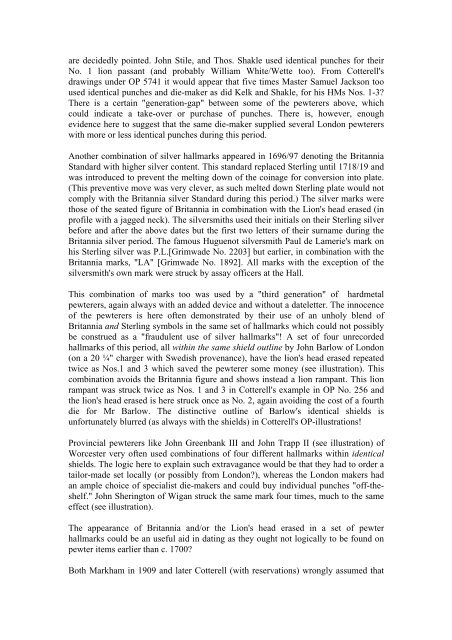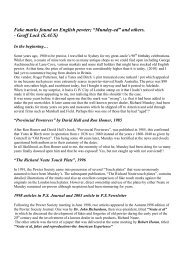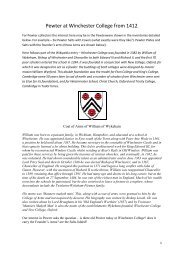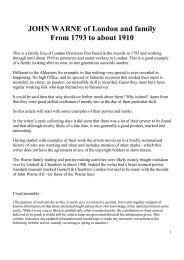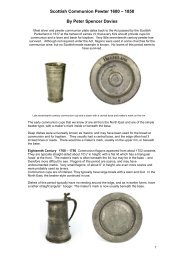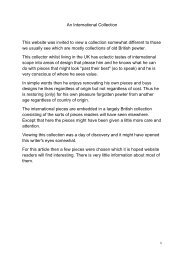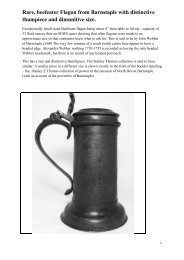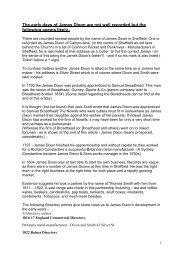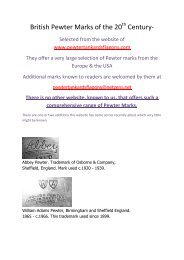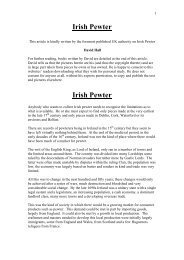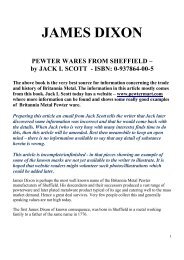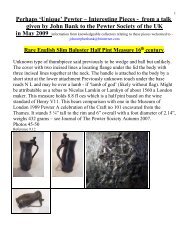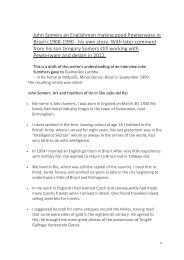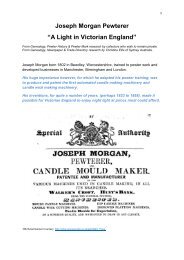Hallmarks - fake and pseudo silver marks on pewter in ... - PewterBank
Hallmarks - fake and pseudo silver marks on pewter in ... - PewterBank
Hallmarks - fake and pseudo silver marks on pewter in ... - PewterBank
Create successful ePaper yourself
Turn your PDF publications into a flip-book with our unique Google optimized e-Paper software.
are decidedly po<strong>in</strong>ted. John Stile, <str<strong>on</strong>g>and</str<strong>on</strong>g> Thos. Shakle used identical punches for their<br />
No. 1 li<strong>on</strong> passant (<str<strong>on</strong>g>and</str<strong>on</strong>g> probably William White/Wette too). From Cotterell's<br />
draw<strong>in</strong>gs under OP 5741 it would appear that five times Master Samuel Jacks<strong>on</strong> too<br />
used identical punches <str<strong>on</strong>g>and</str<strong>on</strong>g> die-maker as did Kelk <str<strong>on</strong>g>and</str<strong>on</strong>g> Shakle, for his HMs Nos. 1-3<br />
There is a certa<strong>in</strong> "generati<strong>on</strong>-gap" between some of the <strong>pewter</strong>ers above, which<br />
could <strong>in</strong>dicate a take-over or purchase of punches. There is, however, enough<br />
evidence here to suggest that the same die-maker supplied several L<strong>on</strong>d<strong>on</strong> <strong>pewter</strong>ers<br />
with more or less identical punches dur<strong>in</strong>g this period.<br />
Another comb<strong>in</strong>ati<strong>on</strong> of <str<strong>on</strong>g>silver</str<strong>on</strong>g> hall<str<strong>on</strong>g>marks</str<strong>on</strong>g> appeared <strong>in</strong> 1696/97 denot<strong>in</strong>g the Britannia<br />
St<str<strong>on</strong>g>and</str<strong>on</strong>g>ard with higher <str<strong>on</strong>g>silver</str<strong>on</strong>g> c<strong>on</strong>tent. This st<str<strong>on</strong>g>and</str<strong>on</strong>g>ard replaced Sterl<strong>in</strong>g until 1718/19 <str<strong>on</strong>g>and</str<strong>on</strong>g><br />
was <strong>in</strong>troduced to prevent the melt<strong>in</strong>g down of the co<strong>in</strong>age for c<strong>on</strong>versi<strong>on</strong> <strong>in</strong>to plate.<br />
(This preventive move was very clever, as such melted down Sterl<strong>in</strong>g plate would not<br />
comply with the Britannia <str<strong>on</strong>g>silver</str<strong>on</strong>g> St<str<strong>on</strong>g>and</str<strong>on</strong>g>ard dur<strong>in</strong>g this period.) The <str<strong>on</strong>g>silver</str<strong>on</strong>g> <str<strong>on</strong>g>marks</str<strong>on</strong>g> were<br />
those of the seated figure of Britannia <strong>in</strong> comb<strong>in</strong>ati<strong>on</strong> with the Li<strong>on</strong>'s head erased (<strong>in</strong><br />
profile with a jagged neck). The <str<strong>on</strong>g>silver</str<strong>on</strong>g>smiths used their <strong>in</strong>itials <strong>on</strong> their Sterl<strong>in</strong>g <str<strong>on</strong>g>silver</str<strong>on</strong>g><br />
before <str<strong>on</strong>g>and</str<strong>on</strong>g> after the above dates but the first two letters of their surname dur<strong>in</strong>g the<br />
Britannia <str<strong>on</strong>g>silver</str<strong>on</strong>g> period. The famous Huguenot <str<strong>on</strong>g>silver</str<strong>on</strong>g>smith Paul de Lamerie's mark <strong>on</strong><br />
his Sterl<strong>in</strong>g <str<strong>on</strong>g>silver</str<strong>on</strong>g> was P.L.[Grimwade No. 2203] but earlier, <strong>in</strong> comb<strong>in</strong>ati<strong>on</strong> with the<br />
Britannia <str<strong>on</strong>g>marks</str<strong>on</strong>g>, "LA" [Grimwade No. 1892]. All <str<strong>on</strong>g>marks</str<strong>on</strong>g> with the excepti<strong>on</strong> of the<br />
<str<strong>on</strong>g>silver</str<strong>on</strong>g>smith's own mark were struck by assay officers at the Hall.<br />
This comb<strong>in</strong>ati<strong>on</strong> of <str<strong>on</strong>g>marks</str<strong>on</strong>g> too was used by a "third generati<strong>on</strong>" of hardmetal<br />
<strong>pewter</strong>ers, aga<strong>in</strong> always with an added device <str<strong>on</strong>g>and</str<strong>on</strong>g> without a dateletter. The <strong>in</strong>nocence<br />
of the <strong>pewter</strong>ers is here often dem<strong>on</strong>strated by their use of an unholy blend of<br />
Britannia <str<strong>on</strong>g>and</str<strong>on</strong>g> Sterl<strong>in</strong>g symbols <strong>in</strong> the same set of hall<str<strong>on</strong>g>marks</str<strong>on</strong>g> which could not possibly<br />
be c<strong>on</strong>strued as a "fraudulent use of <str<strong>on</strong>g>silver</str<strong>on</strong>g> hall<str<strong>on</strong>g>marks</str<strong>on</strong>g>"! A set of four unrecorded<br />
hall<str<strong>on</strong>g>marks</str<strong>on</strong>g> of this period, all with<strong>in</strong> the same shield outl<strong>in</strong>e by John Barlow of L<strong>on</strong>d<strong>on</strong><br />
(<strong>on</strong> a 20 ¼" charger with Swedish provenance), have the li<strong>on</strong>'s head erased repeated<br />
twice as Nos.1 <str<strong>on</strong>g>and</str<strong>on</strong>g> 3 which saved the <strong>pewter</strong>er some m<strong>on</strong>ey (see illustrati<strong>on</strong>). This<br />
comb<strong>in</strong>ati<strong>on</strong> avoids the Britannia figure <str<strong>on</strong>g>and</str<strong>on</strong>g> shows <strong>in</strong>stead a li<strong>on</strong> rampant. This li<strong>on</strong><br />
rampant was struck twice as Nos. 1 <str<strong>on</strong>g>and</str<strong>on</strong>g> 3 <strong>in</strong> Cotterell's example <strong>in</strong> OP No. 256 <str<strong>on</strong>g>and</str<strong>on</strong>g><br />
the li<strong>on</strong>'s head erased is here struck <strong>on</strong>ce as No. 2, aga<strong>in</strong> avoid<strong>in</strong>g the cost of a fourth<br />
die for Mr Barlow. The dist<strong>in</strong>ctive outl<strong>in</strong>e of Barlow's identical shields is<br />
unfortunately blurred (as always with the shields) <strong>in</strong> Cotterell's OP-illustrati<strong>on</strong>s!<br />
Prov<strong>in</strong>cial <strong>pewter</strong>ers like John Greenbank III <str<strong>on</strong>g>and</str<strong>on</strong>g> John Trapp II (see illustrati<strong>on</strong>) of<br />
Worcester very often used comb<strong>in</strong>ati<strong>on</strong>s of four different hall<str<strong>on</strong>g>marks</str<strong>on</strong>g> with<strong>in</strong> identical<br />
shields. The logic here to expla<strong>in</strong> such extravagance would be that they had to order a<br />
tailor-made set locally (or possibly from L<strong>on</strong>d<strong>on</strong>), whereas the L<strong>on</strong>d<strong>on</strong> makers had<br />
an ample choice of specialist die-makers <str<strong>on</strong>g>and</str<strong>on</strong>g> could buy <strong>in</strong>dividual punches "off-theshelf."<br />
John Sher<strong>in</strong>gt<strong>on</strong> of Wigan struck the same mark four times, much to the same<br />
effect (see illustrati<strong>on</strong>).<br />
The appearance of Britannia <str<strong>on</strong>g>and</str<strong>on</strong>g>/or the Li<strong>on</strong>'s head erased <strong>in</strong> a set of <strong>pewter</strong><br />
hall<str<strong>on</strong>g>marks</str<strong>on</strong>g> could be an useful aid <strong>in</strong> dat<strong>in</strong>g as they ought not logically to be found <strong>on</strong><br />
<strong>pewter</strong> items earlier than c. 1700<br />
Both Markham <strong>in</strong> 1909 <str<strong>on</strong>g>and</str<strong>on</strong>g> later Cotterell (with reservati<strong>on</strong>s) wr<strong>on</strong>gly assumed that


